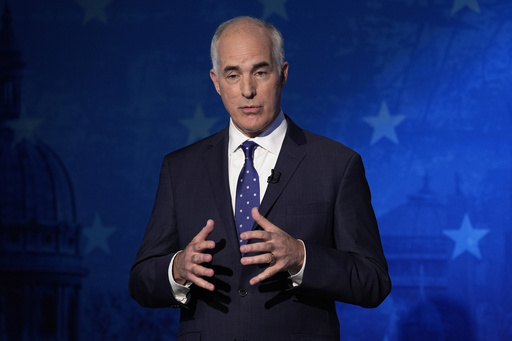
HARRISBURG, Pa. — The recent electoral losses for Democrats in Pennsylvania have sparked a wave of analysis about the party’s future in the state, raising doubts that it may be transitioning away from being a pivotal swing state to adopting a more conservative stance akin to Ohio.
The introspection surrounding voters’ rejection of Democrats coincides with growing speculation about Pennsylvania Governor Josh Shapiro as a 2028 presidential contender.
Shapiro, who is widely anticipated to seek reelection in the 2026 midterms, was viewed as a promising figure in the party, especially after making Vice President Kamala Harris’s shortlist for potential running mates.
Some Pennsylvania Democrats attribute the party’s losses in 2024, at least in part, to Trump supporters who might abstain from voting if he does not appear on the ballot, suggesting that Pennsylvania could retain its status as a crucial swing state.
“I don’t think it’s an indicator for Pennsylvania,” commented Jamie Perrapato, head of Turn PA Blue, an organization that trains campaign volunteers. “We’ll need to see if these voters turn up in other elections beyond the presidency.”
Pennsylvania’s significance as a battleground state in the nation is underscored by the heavy investment in political advertisements, with spending surpassing that in any other state, according to ad-tracking company AdImpact.
Despite a large portion of this funding coming from Democrats, the losses were widespread; they lost all of their 19 electoral votes, a U.S. Senate seat, several statewide races, and multiple congressional seats, as well as a diminishing voter registration edge.
Notably, the Democrats faced a historic defeat, having not lost Pennsylvania’s electoral votes and a Senate incumbent in the same election cycle since 1880. The loss of three-term Senator Bob Casey, known for his longstanding commitment to statewide office since 1997, stood out as a significant blow.
A national conversation about the reasons behind Harris’s defeat is mirrored in Pennsylvania, with no consensus on the causes. Some blame President Biden for reneging on his promise not to run again, while others point fingers at the left wing of the party or Harris herself for failing to connect with working-class voters.
In Philadelphia, a Democratic stronghold, tensions arose between local party officials and Harris’s campaign advisors as they examined Trump’s narrowing margins in the city compared to previous elections. Although historically critical to Democrats, Harris achieved her narrowest margin in Philadelphia since John Kerry in 2004, with turnout beneath the statewide average.
Rural Democrats voiced concerns that the party overlooked voters in their areas, asserting that Harris could have countered Trump’s anti-fracking rhetoric more effectively in a major natural gas state like Pennsylvania.
Former Pennsylvania Governor Ed Rendell stated that Trump’s messaging resonated with voters and criticized Harris for not having enough presence on the campaign trail to rebut it. Still, he maintained that Pennsylvania remains a swing state.
“I wouldn’t be overly concerned about these results,” Rendell remarked. “The previous election saw Democrats winning nearly everything, yet it appears like we nearly lost it all this time around.”
In the 2022 election, Shapiro won the governor’s race by nearly 15%, and John Fetterman, despite facing health challenges, was the only candidate nationally to flip a U.S. Senate seat. Furthermore, Democrats regained control of the state House of Representatives after a 12-year hiatus.
Allegheny County council member Bethany Hallam, part of a group of progressive Democrats who gained office in Pittsburgh, believes there’s an opportunity to prevent Pennsylvania from mirroring Ohio’s political landscape, but warns against viewing 2024 as an isolated incident.
“They’re going to be more motivated to keep voting,” Hallam commented, noting that newly engaged voters might be more persistent in the future.
Looking forward, if Shapiro seeks another term, he may benefit from a historical mid-term backlash against the incumbent party, which has often favored Republicans following their terms.
The political environment is constantly changing, with upcoming elections being influenced by the economy, the trajectory of Trump’s presidency, and unforeseen events.
Rendell anticipates a decline in Trump’s approval ratings, possibly dipping under 40% before he takes office. Meanwhile, Democrats are bracing themselves as Republicans likely aim to challenge Shapiro’s ambitions.
“He’s on the MAGA radar,” remarked Michelle McFall, chair of the Westmoreland County Democratic Party. “He’s a highly popular governor in what remains a vital battleground state, and we are preparing to defend that seat aggressively.”
The state Supreme Court’s partisan control will also face scrutiny in 2025, as three Democratic justices elected a decade ago contend for retention without facing opponents. Republicans are noting this scenario closely.
Democrats now enter these future contests with their narrowest voter registration margin in fifty years. What once was a 1.2 million-voter edge in 2008 is now down to fewer than 300,000 voters.
Researchers from the University of Pennsylvania indicated that recent Republican gains stem from disillusioned Democrats switching licenses to the GOP or independent parties, rather than an influx of new Republican voters.
While Democrats have enjoyed more statewide wins over the last 25 years, the political landscape has reached a tie in the number of elections from 2020 through 2024.
Political science expert Daniel Hopkins argues that predicting Pennsylvania’s trajectory is challenging due to its evolving political landscape. Parties often adapt following losses, making it difficult to define a definitive trend.
Despite Democrats having noted advantages in registration previously, Republicans have consistently remained competitive statewide. Hopkins expressed concern that the Democrats may have lost ground among young and Hispanic voters; however, he noted the swing towards the GOP was moderate in Pennsylvania.
Trump’s slim victory margin of 1.8 percentage points does not suggest a decisive shift but rather highlights that Pennsylvania will remain a crucial competitive entity going forward.
“I don’t view the registration figures as fate,” Hopkins added. “What matters is which party can engage unaffiliated voters effectively, as that will determine the next winners in Pennsylvania.”
